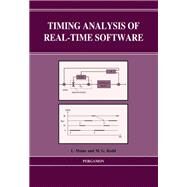Timing Analysis of Real-Time Software : A Practical Approach to the Specification and Design of Real-Time
, by Motus, Leo; Rodd, M. G.- ISBN: 9780080420264 | 0080420265
- Cover: Hardcover
- Copyright: 12/1/1994
The authors set out to address fundamental design issues facing engineers when developing the software for real-time computer-based control systems in which all programs must be safe, reliable, predictable and able to cope with the occurence of faults. Despite rapid progress in computer technology, the attention of designers is still focused on finding logically correct algorithms to implement the required control. It has, however, become evident that this is insufficient and that attention must be paid to meeting the complex timing interactions which occur between the systems under control and the computers controlling them. This book suggests that the answers lie in the use of understandable, engineering-relevant, mathematically sound tools for expressing and analysing the complex temporal interactions. Timing Analysis of Real-Time Software is not a designer's handbook; rather it discusses the nature of the problems involved and how they can be handled. The focus is on the use of modelling techniques based on the so-called Quirk-model, initially developed in the United Kingdom and, over the past decade, extensively developed in institutions in the ex-Soviet Union and Europe. This book shows how the techniques can be used to form the basis of a new generation of CASE (computer assisted software engineering) tools, and examples are given of how these can be used to design embedded systems ranging from digital controllers through to communication protocol handlers.






